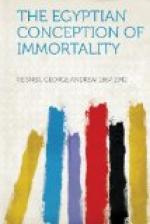Another change comes in the Fourth Dynasty, and is to be noted first in the royal tombs, as is always the case. The Egyptians had now learned to cut stone and build with it. The burial chambers hollowed in the solid rock were necessarily smaller than the old chambers dug in the gravel and no longer sufficient to contain the great mass of furniture gathered by a king for his grave. On the other hand, the chapels with the increase in architectural skill could be build of great size. Corresponding to these technical conditions we find a great increase in the importance of the chapel. It becomes a great temple, whose magazines were filled with all those objects which had formerly been placed in the burial chamber and were so necessary to the life of the spirit. The temples of the third pyramid, for example, contained nearly two thousand stone vessels. Great estates were set aside by will, and the income appointed to the support of certain persons who on their side were obliged to keep up the temple, to make the offerings and to recite the magical formulas which would provide the spirit with all its necessities.
Following closely the growth in importance of the royal chapels, the private offering places assumed a greater importance. The custom of periodic offerings and the use of magical texts grew until it reached its highest point in the Fifth Dynasty. At this time there is a burial chamber deep underground where the dead was laid securely in ancient traditional attitude, with his clothing and a few personal ornaments. As a rule, it is only the women, always conservative, that have anything more. Above this grave, there is a solid rectangular structure, with a chapel or offering place on the side towards the valley. The offering place is always there, no matter how poor or small the tomb. But to understand just what the Egyptian thought, we must turn to the better tombs. The walls are of limestone carved with reliefs representing the important processes of daily life,—sowing, reaping, cattle-herding, hunting, pot-making, weaving,—all those actions which furnish the daily supplies. The dead man is represented overseeing all this. Finally, near the offering niche, he is represented seated, usually with his wife at a table bearing loaves of the traditional ta bread. Beside him are represented heaps of provisions—meat, cakes, vegetables, wine and beer. A list of objects is never missing, marked with numbers,—a thousand loaves of bread, a thousand head of cattle, a thousand jars of wine, a thousand garments, and so on. We know from latter inscriptions that these words, properly recited, created for the spirit a store of spirit objects in equal numbers. Below the niche is an altar for receiving actual offerings of food and drink. It is clear that the living, coming to this offering place with or without material offerings, could, by proper recitation, secure to the spirit of the dead all its daily needs.




